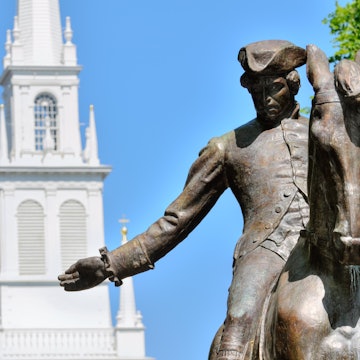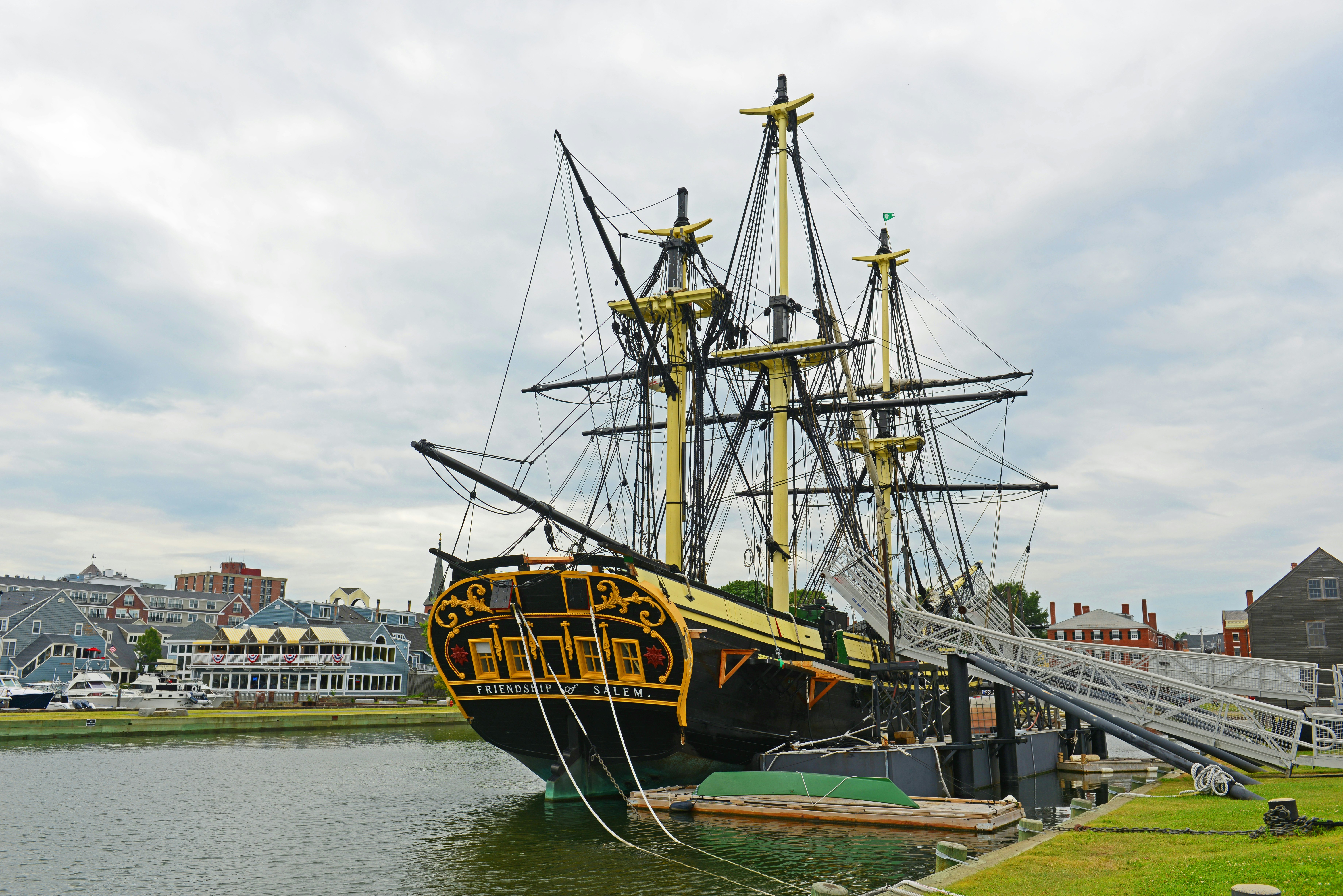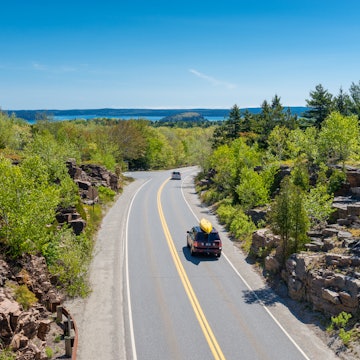

From witch-themed history to iconic architecture, here are the best things to do in Salem. Getty Images
It was 1692 – a dark time indeed – when the residents of Salem village accused hundreds of their own of practicing witchcraft and sent 20 to their death. The so-called Salem witch trials earned the city an ignominious place in history.
Fortunately, "Witch City" has come full circle, now welcoming witches and warlocks, psychics and spiritualists, and alternative thinkers of all types. It is a wonderful and wacky place that embraces the occult in all its spookiness (and sometimes silliness). Salem also has a rich maritime history, a world-class art museum and a cherished literary legacy, thanks to 19th-century author Nathaniel Hawthorne. About 20 miles north of Boston, it is a perfect day trip, accessible by car, train or ferry.
But Salem is also a wonderful destination in its own right, with more than enough engaging history and contemporary culture to entertain you for several days (especially in October).

1. Celebrate the Halloween season at Haunted Happenings
Salem celebrates its witchiness throughout the month of October – the spookiest time of year – with a packed calendar of special events, or Haunted Happenings. Every day in October, there is an artisan market at Derby Sq and creepy art exhibits on Charter St. Local seers set up a Psychic Fair to offer tarot readings, clairvoyant visioning and communication with the dead. And of course, there are many seasonal haunted houses and ghost tours around town: the Lost Museum at Gallows Hill is good for a scare.
On Halloween night, all are invited to join the witch community on Salem Common to mourn and honor their dearly departed at a Samhain ceremony. Check the calendar for other one-time events throughout the month, such as a zombie walk, a costume parade and the legendary Witches’ Ball. No matter what you do, don’t forget to wear a costume. It’s Halloween, after all!
Detour: One of the most fright-filled experiences in the area is Hysteria at Connors Farm in Danvers. The haunted walking trail traverses fields and forests, skirts a murky swamp, and visits an authentic 17th-century burial ground with plenty of creepy characters along the way.

2. Learn about what led to Salem's witch trials
With all the Halloween hype and spellbinding fun, it’s easy to overlook the tragic historical roots to modern Witch City. In 1692, the Puritan village of Salem was consumed with mistrust and panic, as children were afflicted with inexplicable illnesses and accusations flew. In the end, 20 innocent people were executed for witchcraft, while additional victims perished in jail. It’s a fascinating and frightening history, and there’s no better place to learn about it than right here in Salem. For a decent overview, start with the documentary film Salem Witch Hunt: Examine the Evidence at the Salem Armory Visitor Center. For a more in-depth experience, Salem Uncovered offers an excellent 90-minute historical walking tour that examines the underlying causes of the witch trials. In any case, be sure to stop by the Salem Witch Trials Memorial on Liberty St, a simple but moving marker that honors the 20 victims who were executed.
There is an excess of hokey witch-themed museums and activities in town and few actual historical sights related to the affair. The exception is the so-called Witch House, the 17th-century home of Jonathan Corwin, who served as one of the judges for the witch trials. The house museum provides historical context for the tragic episode, addressing the Corwins’ privileged position in society, the prevalent religious beliefs and the fear that pervaded the village at that time.
Planning tip: The Witch House requires advance booking on weekends and throughout the month of October.
3. Sit on the jury at a witch trial reenactment
If you’re still incredulous about how the witch hysteria unfolded, you might put yourself in the shoes of 17th-century Salemites. Cry Innocent is a reenactment of the trial of Bridget Bishop, who was the first person executed for witchcraft in 1692 Salem. In this interactive performance, professional actors portray the neighbors, churchgoers and other witnesses who recount their allegations against the young woman. Pay careful attention, as the audience plays the role of the jury. The theatrics allow viewers to understand how disempowered and terrified defendants might confess (and accuse others) in hopes of saving themselves.
Planning tip: Arrive early to see the arrest of Bridget Bishop in front of the old Town Hall.

4. Find the filming locations from Hocus Pocus
It’s not historically accurate (to say the least), and it was a box office flop, but the 1993 film Hocus Pocus has become a cult classic. The Halloween-themed movie takes place in Salem, and many scenes were filmed around town, including central locations like the Salem Common and the Old Town Hall. Hocus Pocus fans may want to expand their boundaries to find these additional filming locations.
The opening scenes (from 1693 Salem) were filmed at Salem Pioneer Village, an outdoor living history museum that is about a mile south of central Salem. Opening hours are very limited (weekend afternoons only from June through October), so time your visit carefully. Nearby, Max and Dani’s home in the movie is the cool but creepy house at 5 Ocean Ave, with its unmistakable widow’s watch. (Note that it is a private home and not open to the public.) And Alison’s stately abode is none other than the 18th-century Ropes Mansion at 318 Essex St. Operated by the Peabody Essex Museum, the Georgian Colonial beauty is open by guided tour, but the movie features only the exterior, which you can see anytime (along with the mansion’s spectacular gardens).
Detour: Some of the Hocus Pocus cemetery scenes were filmed at Old Burial Hill, a historic graveyard that dates to 1638 in nearby Marblehead. It’s a 4.5-mile drive east of Salem center.
5. Shop on Essex St
Today’s Salem has magically turned its history on its head, embracing modern witchcraft in its many forms. A thriving contemporary witch community operates countless psychic parlors, potion shops and metaphysical bookstores. It’s easy to while away an afternoon exploring the many intriguing venues that line Essex St and environs. Deck out your home with warm, healing vibes from HausWitch; stock up on herbs, teas and essential oils at Artemesia Botanicals; browse the New Age titles at Pyramid Books; or craft your own broom at the Witchery.

6. Discover the city’s seafaring history at the Salem Maritime National Historic Site
Nearly a century after the witch trials, in 1784, Salem merchant Elias Hasket Derby sent his ship Grand Turk to the Cape of Good Hope and onward to Canton. This mission would kick off a flurry of trading expeditions from New England to China and later to India. As such, Salem became a thriving center for the clipper-ship trade with the Far East. Nowadays, the Salem Maritime National Historic Site showcases this illustrious history.
The centerpiece is Derby Wharf, where the tall ship Friendship of Salem is docked. The two-decked, three-masted vessel is a replica of an East Indiaman that was built in Salem in 1797. It’s open to visit on weekends from late May through October. Across Derby St, a gilded eagle sits atop the red-brick US Custom House, where permits were issued and taxes paid (and where writer Nathaniel Hawthorne worked for a time). Other historic buildings include warehouses and historic houses, some of which are open to the public in season (late May through October). Visit the Salem Armory Visitor Center on Liberty St to see an orientation film and to get details about what is open when.
7. Peruse the Peabody Essex Museum’s world-class art collection
In 1799, Salem’s sailors and traders founded the East India Marine Society as a charitable and educational society, including a museum to showcase the "natural and artificial curiosities" brought back from voyages. This was the beginning of the esteemed Peabody Essex Museum, one of the country’s oldest museums. The PEM holds a remarkable collection of Asian art, as well as decorative pieces from New England and loads of maritime artifacts. It has grown into an incredible palace of art and culture from around the world.
Planning tip: A highlight of the PEM collection is Yin Yu Tang, a Qing Dynasty-era merchant house from the Huizhou region. The house shows off a rich architectural heritage and fascinating social insights from its 200 years as a family home.

8. Tour the House of the Seven Gables, a literary and architectural icon
Built in 1688, the iconic Turner-Ingersoll mansion originally had a modest two gables. But the Turner family expanded and embellished over the years, until there were seven. The house was eventually sold to the Ingersoll family, who were relations of Nathaniel Hawthorne. The writer visited often and became fascinated with the house, which inspired his 1851 novel The House of the Seven Gables. It’s now a museum that shows off the house’s intriguing history, insights into the lives of the various residents and relevant details from Hawthorne’s novel (though it’s even better if you read it yourself).
In addition to the seven-gabled centerpiece, there are two historic houses on the grounds, including the birthplace of Nathaniel Hawthorne (which was moved from another location in Salem). The gorgeous seaside gardens are a delight.
Detour: Sample the preferred sweets from Nathaniel Hawthorne’s time at Ye Olde Pepper Candy Co across the street from the House of the Seven Gables. Black Jacks (flavored with blackstrap molasses) and Gibraltars (lemon and mint hard candies) were the first candies produced in the USA, and they are still made using recipes from the early 1800s.
9. Check out the street art in El Punto
The Point is a rough-and-tumble Latinx neighborhood that is only a few blocks but still a world away from Salem’s historic center. In recent years, El Punto – as it’s known by its mostly Spanish-speaking population – has been transformed into an open-air art museum. Local, national and international artists have painted more than 75 murals on the brick walls and buildings of the surrounding neighborhood. The result is a spectacular array of color, images, cultural expression and social commentary, all within a three-block radius. Walk south on Congress St and across the bridge to find the Point.
10. Sample the spirits at Deacon Giles Distillery
There are so many things to love about the Deacon Giles Distillery, starting with the vodka, gins and rums that are crafted here. Then there are the tantalizing cocktails, which you can taste at the on-site Speakeasy Lab (open Thursday through Monday). The bar menu changes frequently but always includes some classic and some creative options, all featuring the housemade spirits. Incidentally, Deacon Giles is a historical figure (of sorts) – an evil rum distiller caricature who was invented and employed by temperance advocates in the 19th century. Contemporary distillers Ian Hunter and Jesse Brenneman reclaimed and repurposed the name, with no small degree of irony, for their deliciously intoxicating spirits.
Planning tip: Learn more about the spirits and how they are made at the Founder’s Tours and Tastings, offered on Saturdays from May to November.
















